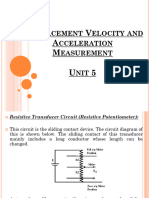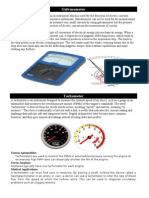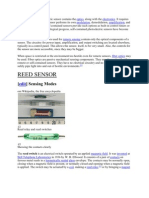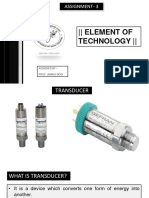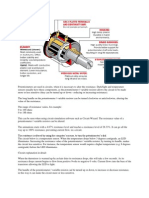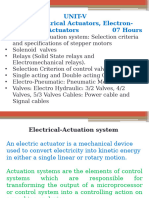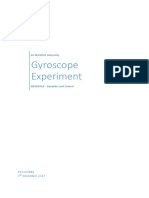SEnsors
SEnsors
Uploaded by
dikoalamCopyright:
Available Formats
SEnsors
SEnsors
Uploaded by
dikoalamOriginal Description:
Copyright
Available Formats
Share this document
Did you find this document useful?
Is this content inappropriate?
Copyright:
Available Formats
SEnsors
SEnsors
Uploaded by
dikoalamCopyright:
Available Formats
Sensors and Detectors
Position and Motion Sensing
Modern linear and digital integrated circuit
technology is used throughout the field of
position and motion sensing. Fully integrated
solutions which combine linear and digital
functions have resulted in cost effective
solutions to problems which in the past have
been solved using expensive electro-mechanical
techniques. These systems are used in many
applications including robotics, computer-aided
manufacturing, factory automation, avionics,
and automotive.
This automation in position and motion sensing
helps in improving the accuracy and efficiency
as well as safety of many industrial and
manufacturing processes.
Position and Motion Sensors
Position and motion- indicating instrumentation
is used in facilities to provide remote indication
of control rod position with respect to the fully
inserted position, and remote indication of the
open or shut condition of important valves. This
remote indication is necessary for the
monitoring of vital components located within
inaccessible or remote areas. Remote position
indication can be used at any facility where
valve position indication is required for safety.
Variable Output Devices
Linear variable differential
Transformers (LVDTS)
The linear variable differential transformer
(LVDT) is an accurate and reliable method for
measuring linear distance. LVDTs find uses in
modern machine-tool, robotics, avionics, and
computerized manufacturing. By the end of
World War II, the LVDT had gained acceptance
as a sensor element in the process control
industry largely as a result of its use in aircraft,
torpedo, and weapons systems.
The LVDT is a position-to-electrical sensor
whose output is proportional to the position of a
movable magnetic core. The core moves linearly
inside a transformer consisting of a center
primary coil and two outer secondary coils
wound on a cylindrical form. The primary
winding is excited with an AC voltage source
(typically several kHz), inducing secondary
1|Page
Sensors and Detectors
voltages which vary with the position of the
magnetic core within the assembly. The core is
attached to the object whose movement or
displacement is being measured.
The secondary windings are wound out of
phase with each other, and when the core
is centered the voltages in the two
secondary windings oppose each other,
and the net output voltage is zero. When
the core is moved off center, the voltage in
the secondary toward which the core is
moved increases, while the opposite
voltage decreases. The result is a
differential voltage output which varies
usually threaded in order to facilitate attachment
to a non-ferromagnetic rod which in turn in
linearly with the core's position. Linearity
is excellent over the design range of
movement, typically 0.5% or better. The
LVDT offers good accuracy, linearity,
sensitivity, infinite resolution, as well as
frictionless operation and ruggedness. A
wide variety of measurement ranges are
available in different LVDTs, typically
from 100m to 25cm. Typical excitation
voltages range from 1V to 24V RMS, with
frequencies from 50Hz to 20kHz.
Potentiometer
Potentiometer valve position indicators) provide
an accurate indication of position throughout the
travel of a valve or control rod. The extension is
physically attached to a variable resistor. As the
extension moves up or down, the resistance of
the attached circuit changes, changing the
amount of current flow in the circuit. The
amount of current is proportional to the valve
position.
Potentiometer valve position indicator failures
are normally electrical in nature. An electrical
short or open will cause the indication to fail at
one extreme or the other. If an increase or
decrease in the potentiometer resistance occurs,
erratic indicated valve position occurs
Synchro Equipment
Remote indication or control may be obtained by
the use of self-synchronizing motors, called
synchro equipment. Synchro equipment consists
of synchro units which electrically govern or
follow the position of a mechanical indicator or
device. An electrical synchro has two distinct
advantages over mechanical indicators:
(1) greater accuracy, and
2|Page
Sensors and Detectors
(2) simpler routing of remote indication.
There are five basic types of synchros which are
designated according to their function. The basic
types are: transmitters, differential transmitters,
receivers, differential receivers, and control
transformers. Figure 1 illustrates schematic
diagrams used to show external connections and
the relative positions of synchro windings. If the
power required to operate a device is higher than
the power available from a synchro, power
amplification is required. Servomechanism is a
term which refers to a variety of poweramplifiers. These devices are incorporated into
synchro systems for automatic control rod
positioning in some reactor facilities.
The transmitter, or synchro generator, consists
of a rotor with a single winding and a stator with
three windings placed 120 degrees apart. When
the mechanical device moves, the mechanically
rotors angular position. Since the rotor is
attached to the mechanical device, the induced
voltage represents the position of the attached
mechanical device. The voltage produced by
each of the windings is utilized to control the
receiving synchro position.
The receiver, or synchro motor, is electrically
similar to the synchro generator. The synchro
receiver uses the voltage generated by each of
the synchro generator windings to position the
receiver rotor. Since the transmitter and receiver
are electrically similar, the angular position of
the receiver rotor corresponds to that of the
synchro transmitter rotor. The receiver differs
mechanically from the transmitter in that it
incorporates a damping device to prevent
hunting.
Hunting refers to the overshoot and undershoot
that occur as the receiving device tries to match
the sending device. Without the damping device,
the receiver would go past the desired point
slightly, then return past the desired point
slightly in the other direction. This would
continue, by smaller amounts each time, until
the receiver came to rest at the desired position.
The damper prevents hunting by feeding some
of the signal back, thus slowing down the
approach to the desired point.
Differential synchros are used with transmitter
and receiver synchros to insert a second signal.
The angular positions of the transmitter and the
differential synchros are compared, and the
difference or sum is transmitted to the receiver.
This setup can be used to provide a feedback
signal to slow the response time of the receiver,
thus providing a smooth receiver motion.
Control transformer synchros are used when
only a voltage indication of angular position is
desired. It is similar in construction to an
ordinary synchro except that the rotor windings
are used only to generate a voltage which is
known as an error voltage. The rotor windings of
3|Page
Sensors and Detectors
a control transformer synchro are wound with
many turns of fine wire to produce a high
impedance. Since the rotor is not fed excitation
voltage, the current drawn by the stator windings
would be high if they were the same as an
ordinary synchro; therefore, they are also wound
with many turns of fine wire to prevent
excessive current.
Switch Position Indicators
Mechanical limit switches and reed switches
provide valve open and shut indications. They
also are used to determine the physical position
of equipment.
Limit Switches
A limit switch is a mechanical device which can
be used to determine the physical position of
equipment. For example, an extension on a valve
shaft mechanically trips a limit switch as it
moves from open to shut or shut to open. The
limit switch gives ON/OFF output that
corresponds to valve position. Normally, limit
switches are used to provide full open or full
shut indications as illustrated in Figure 3.
Many limit switches are the push-button variety.
When the valve extension comes in contact with
the limit switch, the switch depresses to
complete, or turn on, the electrical circuit. As the
valve extension moves away from the limit
switches, spring pressure opens the switch,
turning off the circuit.
Limit switch failures are normally mechanical in
nature. If the proper indication or control
function is not achieved, the limit switch is
probably faulty. In this case, local position
indication should be used to verify equipment
position.
Reed Switches
Reed switches, illustrated in Figure 4, are more
reliable than limit switches, due to their
simplified construction. The switches are
constructed of flexible ferrous strips (reeds) and
are placed near the intended travel of the valve
stem or control rod extension.
the reed switch, the switch shuts. When the
magnet moves away, the reed switch opens. This
ON/OFF indicator is similar to mechanical limit
switches. By using a large number of magnetic
reed switches, incremental position can be
measured. This technique is sometimes used in
monitoring a reactors control rod position.
When using reed switches, the extension used is
a permanent magnet. As the magnet approaches
4|Page
Sensors and Detectors
Failures are normally limited to a reed switch
which is stuck open or stuck shut. If a reed
switch is stuck shut, the open (closed) indication
will be continuously illuminated. If a reed
switch is stuck open, the position indication for
that switch remains extinguished regardless of
valve position.
Rotational motion transducers
Rotational Displacement
Rotational displacement transducers measure the
angular motion of a body about some rotation
axis. They are important not only for measuring
the rotation of bodies such as shafts, but also as
part of systems that measure translational
displacement by converting the translational
motion
to
a
rotary
form.
Circular and Helical Potentiometers
The circular potentiometer is the cheapest device
available
for
measuring
rotational
displacements. It works on almost exactly the
same principles as the translational motion
potentiometer, except that the track is bent round
into a circular shape. The measurement range of
individual devices varies from 010 to 0360
depending on whether the track forms a full
circle or only part of a circle. Where greater
measurement range than 0360 is required, a
helical potentiometer is used, with some devices
being able to measure up to 60 full turns. The
helical potentiometer accommodates multiple
turns of the track by forming the track into a
helix shape. However, its greater mechanical
complexity makes the device significantly more
expensive than a circular potentiometer. The two
forms of device are shown in Figure 20.1.
5|Page
Sensors and Detectors
Both kinds of device give a linear relationship
between the measured quantity and the output
displacement of the slider from its starting
position. However, as with linear track
potentiometers, all rotational potentiometers can
give performance problems due to dirt on the
track causing loss of contact. They also have a
reading because the output voltage measured at
the sliding contact is proportional to the angular
limited life because of wear between the sliding
surfaces. The typical inaccuracy of this class of
devices varies from 1% of full scale for
circular potentiometers down to 0.002% of full
scale for the best helical potentiometers
Rotational Differential Transformer
This is a special form of differential transformer
that measures rotational rather than translational
motion. The method of construction and
connection of the windings is exactly the same
as for the linear variable differential transformer
(LVDT), except that a specially shaped core is
used that varies the mutual inductance between
the windings as it rotates, as shown in Figure
20.2.
Like its linear equivalent, the instrument suffers
no wear in operation and therefore has a very
long life with almost no maintenance
requirements. It can also be modified for
operation in harsh environments by enclosing
the windings inside a protective enclosure.
However, apart from the difficulty of avoiding
some asymmetry between the secondary
windings, great care has to be taken in these
instruments to machine the core to exactly the
right shape. In consequence, the inaccuracy
cannot be reduced below 1%, and even this
level of accuracy is only obtained for limited
excursions of the core of 40 away from the
null position. For angular displacements of 60,
the typical inaccuracy rises to 3%, and the
instrument is unsuitable for measuring
displacements greater than this.
Incremental Shaft Encoders
Incremental shaft encoders are one of a class of
encoder devices that give an output in digital
form. They measure the instantaneous angular
position of a shaft relative to some arbitrary
datum point, but are unable to give any
indication about the absolute position of a shaft.
The principle of operation is to generate pulses
as the shaft whose displacement is being
measured rotates. These pulses are counted and
the total angular rotation inferred from the pulse
count. The pulses are generated either by optical
or by magnetic means and are detected by
suitable sensors. Of the two, the optical system
is considerably cheaper and therefore much
more common. Such instruments are very
convenient for computer control applications, as
the measurement is already in the required
digital form and therefore the usual analogue to
digital signal conversion process is avoided.
An example of an optical incremental shaft
encoder is shown in Figure 20.3. It can be seen
that the instrument consists of a pair of discs,
one of which is fixed and one of which rotates
6|Page
Sensors and Detectors
with the body whose angular displacement is
being measured. Each disc is basically opaque
but has a pattern of windows cut into it. The
fixed disc has only one window and the light
source is aligned with this so that the light
shines through all the time. The second disc has
two tracks of windows cut into it that are
equidistantly spaced around the disc, as shown
in Figure 20.4. Two light detectors are
positioned beyond the second disc so that one is
aligned with each track of windows.
As the second disc rotates, light alternately
enters and does not enter the detectors, as
windows and then opaque regions of the disc
pass in front of them. These pulses of light are
fed to a counter, with the final count after
motion has ceased corresponding to the angular
position of the moving body relative to the
starting position. The primary information about
the magnitude of rotation is obtained by the
detector aligned with the outer track of
windows. The pulse count obtained from this
gives no information about the direction of
rotation, however. Direction information is
provided by the second, inner track of windows,
which have an angular displacement with
respect to the outer set of windows of half a
window width. The pulses from the detector
aligned with the inner track of windows
therefore lag or lead the primary set of pulses
according to the direction of rotation.
The
maximum
measurement
resolution
obtainable is limited by the number of windows
that can be machined onto a disc. The maximum
number of windows per track for a 150 mmdiameter disc is 5000, which gives a basic
angular measurement resolution of 1 in 5000. By
using more sophisticated circuits that increment
the count on both the rising and falling edges of
the pulses through the outer track of windows, it
is possible to double the resolution to a
maximum of 1 in 10 000. At the expense of even
greater complexity in the counting circuit, it is
7|Page
Sensors and Detectors
possible also to include the pulses from the inner
track of windows in the count, so giving a
maximum measurement resolution of 1 in 20
000.
Coded-Disc Shaft Encoders
Unlike the incremental shaft encoder that gives a
digital output in the form of pulses that have to
be counted, the digital shaft encoder has an
output in the form of a binary number of several
digits that provides an absolute measurement of
shaft position. Digital encoders provide high
accuracy and reliability. They are particularly
useful for computer control applications, but
they have a significantly higher cost than
incremental encoders. Three different forms
exist, using optical, electrical and magnetic
energy systems respectively.
Optical Digital Shaft Encoder
The optical digital shaft encoder is the cheapest
form of encoder available and is the one used
most commonly. It is found in a variety of
applications, and one where it is particularly
popular is in measuring the position of rotational
joints in robot manipulators. The instrument is
The fixed disc has a single window, and the
principal way in which the device differs from
the incremental shaft encoder is in the design of
the windows on the movable disc, as shown in
Figure 20.6. These are cut in four or more tracks
instead of two and are arranged in sectors as
well as tracks. An energy detector is aligned
with each track, and these give an output of 1
when energy is detected and an output of 0
otherwise.
The measurement resolution obtainable depends
on the number of tracks used. For a four-track
version, the resolution is 1 in 16, with
progressively higher measurement resolution
being attained as the number of tracks is
increased. These binary outputs from the
similar in physical appearance to the incremental
shaft encoder. It has a pair of discs (one movable
and one fixed) with a light source on one side
and light detectors on the other side, as shown in
Figure 20.5.
detectors are combined together to give a binary
number of several digits. The number of digits
corresponds to the number of tracks on the disc,
which in the example shown in Figure 20.6 is
four. The pattern of windows in each sector is
cut such that, as that particular sector passes
across the window in the fixed disc, the four
energy detector outputs combine to give a
unique binary number.
In the binary-coded example shown in Figure
20.6, the binary number output increments by
one as each sector in the rotating disc passes in
turn across the window in the fixed disc. Thus
the output from sector 1 is 0001, from sector 2 is
0010, from sector 3 is 0011, etc.
8|Page
Sensors and Detectors
Contacting (Electrical) Digital Shaft Encoder
The contacting digital shaft encoder consists of
only one disc that rotates with the body whose
displacement is being measured. The disc has
conducting and non-conducting segments rather
than the transparent and opaque areas found on
the movable disc of the optical form of
instrument, but these are arranged in an identical
pattern of sectors and tracks. The disc is charged
to a low potential by an electrical brush in
contact with one side of the disc, and a set of
brushes on the other side of the disc measures
the potential in each track.
The output of each detector brush is interpreted
as a binary value of 1 or 0 according to
whether the track in that particular segment is
conducting or not and hence whether a voltage is
sensed or not. As for the case of the optical form
of instrument, these outputs are combined
together to give a multi-bit binary number.
Contacting digital shaft encoders have a similar
cost to the equivalent optical instruments and
have operational advantages in severe
environmental conditions of high temperature or
mechanical shock. They suffer from the usual
problem of output ambiguity at the sector
boundaries but this problem is overcome by the
same methods as used in optical instruments.
Magnetic Digital Shaft Encoder
Magnetic digital shaft encoders consist of a
single rotatable disc, as in the contacting form of
encoder discussed in the previous section. The
pattern of sectors and tracks consists of
magnetically conducting and non-conducting
segments, and the sensors aligned with each
track consist of small toroidal magnets. Each of
these sensors has a coil wound on it that has a
high or low voltage induced in it according to
the magnetic field close to it. This field is
dependent on the magnetic conductivity of that
segment of the disc that is closest to the toroid.
These instruments have no moving parts in
contact and therefore have a similar reliability to
optical devices. Their major advantage over
optical equivalents is an ability to operate in
very
harsh
environmental
conditions.
Unfortunately, the process of manufacturing and
accurately aligning the toroidal magnet sensors
required makes such instruments very
expensive. Their use is therefore limited to a few
applications where both high measurement
resolution and also operation in harsh
environments are required.
9|Page
Sensors and Detectors
The Resolver
The resolver, also known as a synchro-resolver, is an electromechanical device that gives an analogue
output by transformer action. Physically, resolvers resemble a small a.c. motor and have a diameter
ranging from 10mm to 100 mm. They are frictionless and reliable in operation because they have no
contacting moving surfaces, and consequently they have a long life. The best devices give measurement
resolutions of 0.1%.
Resolvers have two stator windings, which are mounted at right angles to one another, and a rotor, which
can have either one or two windings. As the angular position of the rotor changes, the output voltage
changes. The simpler configuration of a resolver with only one winding on the rotor is illustrated in
Figure 20.8. This exists in two separate forms that are distinguished according to whether the output
voltage changes in amplitude or changes in phase as the rotor rotates relative to the stator winding.
Varying Amplitude Output Resolver
The stator of this type of resolver is excited with a single-phase sinusoidal voltage of frequency , where
the amplitudes in the two windings are given by:
This relationship between shaft angle position and output voltage is non-linear, but approximate linearity
is obtained for small angular motions where (-) < 15. An intelligent version of this type of resolver is
now available that uses a microprocessor to process the sine and cosine outputs, giving a measurement
resolution of 2 minutes of arc.
Varying Phase Output Resolver
This is a less common form of resolver but it is
used in a few applications. The stator windings
are excited with a two-phase sinusoidal voltage
of frequency , and the instantaneous voltage
amplitudes in the two windings. This represents
a linear relationship between shaft angle and the
phase shift of the rotor output relative to the
stator excitation voltage. The accuracy of shaft
rotation measurement depends on the accuracy
with which the phase shift can be measured.
This can be improved by increasing the
excitation frequency, , and it is possible to
reduce inaccuracy to 0.1%. However,
increasing the excitation frequency also
increases magnetizing losses. Consequently, a
10 | P a g e
Sensors and Detectors
compromise excitation frequency of about 400
Hz is used.
The Rotary Inductosyn
This instrument is similar in operation to the
linear inductosyn, except that it measures rotary
displacements and has tracks that are arranged
radially on two circular discs, as shown in
Figure 20.12. Typical diameters of the
instrument vary between 75mm and 300 mm.
The larger versions give a measurement
resolution of up to 0.05 seconds of arc. Like its
linear equivalent, however, the rotary inductosyn
has a very small measurement range, and a
lower-resolution, rotary displacement transducer
with a larger measurement range must be used in
conjunction with it.
Mechanical gyroscopes
Mechanical gyroscopes consist essentially of a
large, motor driven wheel whose angular
momentum is such that the axis of rotation tends
to remain fixed in space, thus acting as a
reference point. The gyro frame is attached to
the body whose motion is to be measured. The
output is measured in terms of the angle between
the frame and the axis of the spinning wheel.
Two different forms of mechanical gyroscope
are used for measuring angular displacement, the
free gyro and the rate-integrating gyro. A third
type of mechanical gyroscope, the rate gyro,
measures angular velocity.
Free gyroscope
The free gyroscope is illustrated in Figure 20.13.
This measures the absolute angular rotation of
the body to which its frame is attached about
two perpendicular axes.
11 | P a g e
Sensors and Detectors
The
instrument
can
measure
angular
displacements of up to 10 with a high accuracy.
For greater angular displacements, interaction
between the measurements on the two
perpendicular axes starts to cause a serious loss
of accuracy. The physical size of the coils in the
motor-action driven system also limits the
measurement range to 10.
For these reasons, this type of gyroscope is only
suitable for measuring rotational displacements
of up to 10. A further operational problem of
free gyroscopes is the presence of angular drift
(precession) due to bearing friction torque. This
has a typical magnitude of 0.5 per minute and
means that the instrument can only be used over
short time intervals of say, 5 minutes. This time
duration can be extended if the angular
momentum of the spinning wheel is increased.
A major application of gyroscopes is in inertial
navigation systems. Only two free gyros
mounted along orthogonal axes are needed to
monitor motions in three dimensions, because
each instrument measures displacement about
two axes. The limited angular range of
measurement is not usually a problem in such
applications, as control action prevents the error
in the direction of motion about any axis ever
exceeding one or two degrees. Precession is a
much greater problem, however, and for this
reason, the rate-integrating gyro is used much
more commonly.
Optical gyroscopes
Optical gyroscopes have been developed only
recently and come in two forms, the ring laser
gyroscope and the fibre-optic gyroscope. The
ring laser gyroscope consists of a glass ceramic
chamber containing a heliumneon gas mixture
in which two laser beams are generated by a
single anode/twin cathode system, as shown in
Figure 20.15.
12 | P a g e
Sensors and Detectors
Three mirrors, supported by the ceramic block
and mounted in a triangular arrangement, direct
the pair of laser beams around the cavity in
opposite directions. Any rotation of the ring
affects the coherence of the two beams, raising
one in frequency and lowering the other. The
clockwise and anticlockwise beams are directed
into a photodetector that measures the beat
frequency according to the frequency difference,
which is proportional to the angle of rotation.
The advantages of the ring laser gyroscope are
considerable. The measurement accuracy
obtained is substantially better than that afforded
by mechanical gyros in a similar price range.
The device is also considerably smaller
physically, which is of considerable benefit in
many applications.
Conclusion
Recently linear and digital integrated circuit
technology is used throughout the field of
position and motion sensing. Fully integrated
solutions which combine linear and digital
functions have resulted in cost effective
Position and motion- indicating or sensing were
used efficiently in facilities to provide remote
indication of control rod position, and remote
indication of the open or shut condition of
important valves use in industrial processes.
Among the devices used are variable output
devices (potentiometer and LVDTs), positionindicating switches, synchronous equipment,
rotational motion transducers, resolvers, and
gyroscopes.
solutions to problems. This automation in
position and motion sensing has been a great aid
in improving the accuracy and efficiency as well
as safety of many industrial and manufacturing
processes.
With the use of these remote indicating and
sensing devices the monitoring of vital
components located within inaccessible or
remote areas has easily facilitated. These
improvements has been proven to promote costeffective production as well as it promotes safe
and efficient work environment
References
DOE Handbook of Instrumentation and Controls.pdf
Position and Motion Sensors by Walt Kester
13 | P a g e
Sensors and Detectors
Sound and Light
LIGHT
Electromagnetic Wave Theory
Light is just one portion of the various
electromagnetic waves flying through space.
The electromagnetic spectrum covers an
extremely broad range, from radio waves with
wavelengths of a meter or more, down to x-rays
At
x-ray
and
shorter
wavelengths,
electromagnetic radiation tends to be quite
particle like in its behavior, whereas toward the
long wavelength end of the spectrum the
behavior is mostly wavelike. The visible portion
occupies an intermediate position, exhibiting
both wave and particle properties in varying
degrees.
Like all electromagnetic waves, light waves can
interfere with each other, become directionally
with wavelengths of less than a billionth of a
meter. Optical radiation lies between radio
waves and x-rays on the spectrum, exhibiting a
unique mix of ray, wave, and quantum
properties.
polarized, and bend slightly when passing an
edge. These properties allow light to be filtered
by wavelength or amplified coherently as in a
laser. In radiometry, lights propagating
wavefront is modeled as a ray traveling in a
straight line. Lenses and mirrors redirect these
rays along predictable paths. Wave effects are
insignificant in an incoherent, large scale optical
system because the light waves are randomly
distributed and there are plenty of photons.
Light Measurement
Many systems and methods have been devised
to quantify light sources so that communication
of color would become easier and more
accurate. These methods attempt to provide a
way of expressing a light sources color and
14 | P a g e
Sensors and Detectors
energy output and tolerances numerically, in
the same way we express length and weight.
Some of these include:
Chromaticity coordinate color spaces
MacAdam Elipses
Luminance and Illuminance Values
Correlated Color Temperature
Standard Illuminants
Spectral Power Distribution
Color Rendering Index
Radiometry
Radiometry is the science of measuring light in
any portion of the electromagnetic spectrum. In
practice, the term is usually limited to the
measurement of infrared, visible, and ultraviolet
light using optical instruments.
There are two aspects of radiometry: theory and
practice. The practice involves the scientific
instruments and materials used in measuring
light, including radiation thermocouples,
bolometers,
photodiodes
,photosensitive dyes and emulsions, vacuum
phototubes, charge-coupled devices, and a
plethora of others. What we are interested in,
however, is the theory.
few paragraphs. Unfortunately, they rarely
discuss the topic in enough detail to be useful.
Shorn of convoluted mathematics and obtuse
definitions, radiometric theory is simple and
easily understood.
Radiometric theory is such a simple topic that
most texts on physics and optics discuss it in a
Radiant Energy
Light is radiant energy. Electromagnetic
radiation (which can be considered both a wave
and a particle, depending on how you measure
it) transports energy through space. When light
is absorbed by a physical object, its energy is
converted into some other form. A microwave
oven, for example, heats a glass of water when
its microwave radiation is absorbed by the water
molecules. The radiant energy of the
microwaves is converted into thermal energy
(heat). Similarly, visible light causes an electric
current to flow in a photographic light meter
when its radiant energy is transferred to the
electrons as kinetic energy.
Radiant energy (denoted as Q) is measured in
joules.
Spectral Radiant Energy
A broadband source such as the Sun emits
electromagnetic radiation throughout most of the
electromagnetic spectrum, from radio waves to
gamma rays. However, most of its radiant
energy is concentrated within the visible portion
of the spectrum. A single-wavelength laser, on
the other hand, is a monochromatic source; all of
its radiant energy is emitted at one specific
wavelength.
From this, we can define spectral radiant energy,
which is the amount of radiant energy per unit
wavelength interval at wavelength . It is
defined as:
Q=dQ/d
Spectral radiant energy is measured in joules per
nanometer
Radiant Flux (Radiant Power)
Energy per unit time is power, which we
measure in joules per second, or watts. A laser
beam, for example, has so many milliwatts or
watts of radiant power. Light flows through
space, and so radiant power is more commonly
referred to as the time rate of flow of radiant
energy, or radiant flux. It is defined as:
15 | P a g e
Sensors and Detectors
=dQ/dt (2)
where Q is radiant energy and t is time.
In terms of a photographic light meter measuring
visible light, the instantaneous magnitude of the
electric current is directly proportional to the
radiant flux. The total amount of current
measured over a period of time is directly
proportional to the radiant energy absorbed by
the light meter during that time. This is how a
photographic flash meter works -- it measures
the total amount of radiant energy received from
a camera flash.
The flow of light through space is often
represented by geometrical rays of light such as
those used in computer graphics ray tracing.
They can be thought of as infinitesimally thin
lines drawn through space that indicate the
direction of flow of radiant energy (light). They
are also mathematical abstractions -- even the
thinnest laser beam has a finite cross section.
Nevertheless, they provide a useful aid to
understanding radiometric theory.
Radiant flux is measured in watts.
Radiance
Radiance is best understood by first visualizing
it. Imagine ray of light arriving at or leaving a
point on a surface in a given direction. Radiance
is simply the infinitesimal amount of radiant flux
contained in this ray.
A more formal definition of radiance requires
that we think of a ray as being an infinitesimally
narrow (elemental) cone with its apex at a
point on a real or imaginary surface. This cone
has a differential solid angle d that is measured
in steradians.
We must also note that the ray is intersecting the
surface at an angle. If the area of intersection
with the surface has a differential cross-sectional
area dA, the cross-sectional area of the ray is
dAcos, where is the angle between the ray
and the surface normal, as shown in Figure 2.
(The ray cross-sectional area dAcos is called
the projected area of the ray-surface intersection
area dA. The same term is used when referring
to finite areas A.)
With these preliminaries in mind, we can
imagine an elemental cone d containing a ray
of light that is arriving at or leaving a surface
(Figs. 3a and 3b). The definition of radiance is
then:
Photometry
Photometry is the science of measuring visible
light in units that are weighted according to the
sensitivity of the human eye. It is a quantitative
science based on a statistical model of the
human visual response to light -- that is, our
perception of light -- under carefully controlled
conditions.
The human visual system is a marvelously
complex and highly nonlinear detector of
electromagnetic radiation with wavelengths
ranging from 380 to 770 nanometers (nm). We
see light of different wavelengths as a
continuum of colors ranging through the visible
spectrum: 650 nm is red, 540 nm is green, 450
nm is blue, and so on.
The sensitivity of the human eye to light varies
with wavelength. A light source with a radiance
2
of one watt/m -steradian of green light, for
example, appears much brighter than the same
2
source with a radiance of one watt/m -steradian
of red or blue light. In photometry, we do not
measure watts of radiant energy. Rather, we
attempt to measure the subjective impression
produced by stimulating the human eye-brain
visual system with radiant energy.
This task is complicated immensely by the eyes
nonlinear response to light. It varies not only
with wavelength but also with the amount of
radiant flux, whether the light is constant or
16 | P a g e
Sensors and Detectors
flickering, the spatial complexity of the scene
being perceived, the adaptation of the iris and
retina, the psychological and physiological state
of the observer, and a host of other variables.
human visual system as a function of
wavelength. It provides a weighting function
that can be used to convert radiometric into
photometric measurements.
Nevertheless, the subjective impression of
seeing can be quantified for normal viewing
conditions. In 1924, the Commission
Internationale
dEclairage
(International
Commission on Illumination, or CIE) asked over
one hundred observers to visually match the
brightness of monochromatic light sources
with different wavelengths under controlled
conditions. The statistical result -- the so-called
CIE photometric curve shown in Figure 6 -shows the photopic luminous efficiency of the
Photometric theory does not address how we
perceive colors. The light being measured can be
monochromatic or a combination or continuum
of wavelengths; the eyes response is determined
by the CIE weighting function. This underlines a
crucial point: The only difference between
radiometric and photometric theory is in their
units of measurement.
Luminous Intensity
The foundations of photometry were laid in
1729 by Pierre Bouguer. In his LEssai
dOptique, Bouguer discussed photometric
principles in terms of the convenient light source
of his time: a wax candle. This became the basis
of the point source concept in photometric
theory.
Wax candles were used as national light source
standards in the 18th and 19th centuries.
England, for example, used spermaceti (a wax
derived from sperm whale oil). These were
replaced in 1909 by an international standard
based on a group of carbon filament vacuum
lamps and again in 1948 by a crucible
containing liquid platinum at its freezing point.
Today the international standard is a theoretical
point source that has a luminous intensity of one
candela (the Latin word for candle). It emits
monochromatic radiation with a frequency of
12
540 x 10 Hertz (or approximately 555 nm,
corresponding with the wavelength of maximum
photopic luminous efficiency) and has a radiant
intensity (in the direction of measurement) of
1/683 watts per steradian.
Together with the CIE photometric curve, the
candela provides the weighting factor needed to
convert between radiometric and photometric
measurements. Consider, for example, a
monochromatic point source with a wavelength
of 510 nm and a radiant intensity of 1/683 watts
per steradian. The photopic luminous efficiency
at 510 nm is 0.503. The source therefore has a
luminous intensity of 0.503 candela.
Luminous Flux (Luminous Power)
Luminous flux is photometrically weighted
radiant flux (power). Its unit of measurement is
the lumen, defined as 1/683 watts of radiant
12
power at a frequency of 540 x 10 Hertz. As
with luminous intensity, the luminous flux of
light with other wavelengths can be calculated
using the CIE photometric curve.
A point source having a uniform (isotropic)
luminous intensity of one candela in all
directions (i.e., a uniform intensity distribution)
emits one lumen of luminous flux per unit solid
angle (steradian).
17 | P a g e
Sensors and Detectors
Luminous Flux Density
Luminous flux density is photometrically
weighted radiant flux density. Illuminance is the
photometric equivalent of irradiance, whereas
luminous exitance is the photometric equivalent
of radiant exitance.
Luminous flux density is measured in lumens
per square meter. (A footcandle is one lumen per
square foot.)
Luminance
Luminance is photometrically weighted
radiance. In terms of visual perception, we
perceive luminance. It is an approximate
measure of how bright a surface appears when
we view it from a given direction. Luminance
used to be called photometric brightness. This
term is no longer used in illumination
engineering because the subjective sensation of
visual brightness is influenced by many other
physical, physiological, and psychological
factors. Luminance is measured in lumens per
square meter per steradian.
Light Measuring Instruments
And Detectors
Sensitivity to the band of interest is a primary
consideration when choosing a detector. You
can control the peak responsivity and bandwidth
through the use of filters, but you must have
adequate signal to start with. Filters can suppress
out of band light but cannot boost signal.
Another consideration is blindness to out of
band radiation. If you are measuring solar
ultraviolet in the presence of massive amounts of
visible and infrared light, for example, you
would select a detector that is insensitive to the
long wavelength light that you intend to filter
out. Lastly, linearity, stability and durability are
considerations. Some detector types must be
cooled or modulated to remain stable. High
voltages are required for other types.
Phototube/ Photodiodes
The phototube is a light sensor that is based on the
photoemissive effect. The phototube is a bipolar tube
which consists of a photoemissive cathode surface
that emits electrons in proportion to incident light,
and an anode which
collects the emitted electrons. The anode must be
biased at a high voltage (50 to 90 V) in order to
attract electrons to jump through the vacuum of the
tube. Some phototubes use forward bias of less than
15 volts, however.
The cathode material determines the spectral
sensitivity of the tube. Solar-blind vacuum
photodiodes use Cs-Te cathodes to provide
sensitivity only to ultraviolet light, providing as much
as a million to one long wavelength rejection. A UV
glass window is required for sensitivity in the UV
down to 185 nm, with fused silica windows offering
transmission down to 160 nm.
Multi-Junction Thermopiles
The thermopile is a heat sensitive device that
measures radiated heat. The sensor is usually
sealed in a vacuum to prevent heat transfer
except by radiation. A thermopile consists of a
number of thermocouple junctions in series
which convert energy into a voltage using the
Peltier effect.
Thermopiles are convenient sensor for
measuring the infrared, because they offer
adequate sensitivity and aflat spectral response
in a small package. More sophisticated
bolometers and pyroelectric detectors need to be
chopped and are generally used only in
18 | P a g e
Sensors and Detectors
calibration labs. Thermopiles suffer from
temperature drift, since the reference portion of
the detector is constantly absorbing heat. The
best method of operating a thermal detector is by
chopping incident radiation, so that drift is
zeroed out by the modulated reading. The quartz
window in most thermopiles is adequate for
transmitting from 200 to 4200 nm, but for long
wavelength sensitivity out to 40 microns,
Potassium Bromide windows are used.
Fiber Optics
Fiber optics allow measurements in tight places
or where irradiance levels and heat are very
high. Fiber optics consist of a core fiber and a
jacket with an index of refraction chosen to
maximize total internal reflection. Glass fibers
are suitable for use in the visible, but quartz or
fused silica is required for transmission in the
ultraviolet. Fibers are often used to continuously
monitor UV curing ovens, due to the attenuation
and heat protection they provide. Typical fiber
optics restrict the field of view to about 20 in
the visible and 10 in the ultraviolet.
Integrating Spheres
An integrating sphere is a hollow sphere coated
inside with Barium Sulfate, a diffuse white
reflectance coating that offers greater than 97%
reflectance between 450 and 900 nm. The sphere
is baffled internally to block direct and first-
bounce light. Integrating spheres are used as
sources of uniform radiance and as input optics
for measuring total power. Often, a lamp is place
inside the sphere to capture light that is emitted
in any direction.
High Gain Lenses
In situations with low irradiance from a point
source, high gain input optics can be used to
amplify the light by as much as 50 times while
ignoring off angle ambient light. Flash sources
such as tower beacons often employ fresnel
lenses, making near field measurements
difficult. With a high gain lens, you can measure
a flash source from a distance without
compromising signal strength. High gain lenses
restrict the field of view to 8, so cannot be
used in full immersion applications where a
cosine response is required.
Filtered Colorimeter / Photometer
Instruments designed for measuring the color of
light, which use three or four filters with a
spectral sensitivity matched to the CIE
Tristimulus color matching functions, is known
as filter colorimeter.
signals which directly yield the standard XYZ
Tristimulus values.
Beside chromaticity measurements, these meters
usually include one of the 4 basic photometric
measurements such as luminance, illuminance,
luminous intensity, or luminous flux. These
instruments use a detector, typically high quality
photodiodes with series-connected filters. The
incident light is converted by the detector into
19 | P a g e
Sensors and Detectors
Spectroradiometer
Spectroradiometers are the most accurate for
measuring spectral energy distribution of any
light source. They are used for determining not
only the radiometric and photometric quantities,
but also the colorimetric quantities of a light
source.
functions. The Tristimulus values are then used
to compute CIE chromaticity coordinates and
luminosity, which provide a complete
description of the color including chromaticity
spectral power, illuminance and luminance.
Dispersion of light is usually accomplished in
Spectroradiometers by means of prisms or
Spectral data is used to calculate the CIE
Tristimulus
values
by
mathematically
integrating the data with the CIE x(), y(), z()
diffraction gratings.
SOUND
Sound is such a common part of everyday life
that we rarely appreciate all of its functions. It
provides enjoyable experiences such as listening
to music or to the singing of birds. It enables
spoken communication with family and friends.
It can alert or warn us and also permits us to
make quality evaluations and
Yet, too often in our modern society, sound
annoys us. Many sounds are unpleasant or
unwanted these are called noise. However,
the level of annoyance depends not only on the
quality
of
the
sound
Importance of Sound Measurement
Measurements provide definite quantities which
describe and rate sounds. These measurements
can provide benefits such as improved building
acoustics and loudspeakers, thus increasing our
enjoyment of music, both in the concert hall and
at home.
different conditions. Sound measurements also
give a clear indication of when a sound may
cause damage to hearing and permit corrective
measures to be taken. The degree of hearing
damage can be determined by audiometry
which measures a person's hearing sensitivity.
Sound measurements also permit precise,
scientific analysis of annoying sounds. However,
we must remember that due to the physiological
and
psychological
differences
between
individuals, the degree of annoyance cannot be
scientifically measured for a given person.
Thus, sound measurements are a vital part of
hearing conservation programmes. Finally,
measurement and analysis of sound is a
powerful diagnostic tool in noise reduction
programmes from airports, to factories,
highways, homes and recording studios. It is a
tool which can help to improve the quality of our
lives.
But the measurements do give us an objective
means of comparing annoying sounds under
Definition of Sound
Sound may be defined as any pressure
variation (in air, water or other medium) that
the human ear can detect. The most familiar
instrument for measuring pressure variations in
20 | P a g e
Sensors and Detectors
air is the barometer. However, the pressure
variations which occur with changing weather
conditions are much too slow for the human ear
to detect and hence do not meet our definition
of sound. But, if variations in atmospheric
pressure occur more rapidly at least 20 times
a second they can be heard and hence are
called sound. (A barometer cannot respond
quickly enough and therefore cannot be used to
measure sound).
The number of pressure variations per second is
called the frequency of the sound, and is
measured in Hertz (Hz). The frequency of a
sound produces it's distinctive tone. Thus, the
rumble of distant thunder has a low frequency,
while a whistle has a high frequency. The
normal range of hearing for a healthy young
person extends from approximately 20 Hz up to
20 000 Hz (or 20 kHz) while the range from the
lowest to highest note of a piano is 27,5 Hz to
4186 Hz.
These pressure variations travel through any
elastic medium (such as air) from the source of
the sound to the listener's ears. You probably
already have some idea of the speed of sound
from the familiar rule for determining how far
away a thunder storm is: count 3 seconds per
kilometer or 5 seconds per mile from the time
you see the lightning until you hear the thunder.
This time interval corresponds to a speed of
sound in air of 1238 km/hour or 770 miles per
hour. For acoustic and sound measurement
purposes, this speed is expressed 4 as 344 meters
per second at room temperature.
The dB
The second main quantity used to describe a
sound is the size or amplitude of the pressure
fluctuations.
The weakest sound a healthy human ear can
detect has an amplitude of 20 millionths of a
Pascal (20 Pa) some 5000000000 times less
than normal atmospheric pressure. A pressure
change of 20 Pa is so small that it causes the
eardrum to deflect a distance less than the
diameter of a single hydrogen molecule.
Amazingly, the ear can tolerate sound pressures
more than a million times higher. Thus, if we
measured sound in Pa, we would end up with
some quite large, unmanageable numbers. To
avoid this, another scale is used the decibel
or dB scale.
The decibel is not an absolute unit of
measurement. It is a ratio between a measured
quantity and an agreed reference level. The dB
scale is logarithmic and uses the hearing
threshold of 20 Pa as the reference level. This
is defined as 0 dB. When we multiply the sound
pressure in Pa by 10, we add 20 dB to the dB
level. So 200 Pa corresponds to 20 dB (re 20
Pa), 2000 Pa to 40 dB and so on. Thus, the
dB scale compresses a range of a million into a
range of only 120 dB.
The sound pressure levels (SPL) in dB and Pa
of various familiar sounds are shown in the
figure.
One useful aspect of the decibel scale is that it
gives a much better approximation to the human
perception of relative loudness than the Pascal
scale. This is because the ear reacts to a
logarithmic change in level, which corresponds
to the decibel scale where 1 dB is the same
relative change everywhere on the scale.
The Basic Sound Level Meter
A sound level meter is an instrument designed to
respond to sound in approximately the same way
as the human ear and to give objective,
reproducible measurements of sound pressure
level. There are many different sound measuring
systems available. Although different in detail,
each system consists of a microphone, a
processing section and a read-out unit.
21 | P a g e
Sensors and Detectors
The microphone converts the sound signal to an
equivalent electrical signal. The most suitable
type of microphone for sound level meters is the
condenser microphone, which combines
precision with stability and reliability. The
electrical signal produced by the microphone is
quite small and so it is amplified by a
preamplifier before being processed.
When more detailed information about a
complex sound is required, the frequency range
from 20 Hz to 20 kHz can be divided up into
sections or bands. This is done with electronic
filters which reject all sound with frequencies
outside the selected band. These bands usually
have a bandwidth of either one octave or one
third octave.
An octave is a frequency band where the highest
frequency is twice the lowest frequency. For
example, an octave filter with a centre
frequency of 1 kHz admits frequencies between
707 and 1414 Hz, but rejects all others. (The
Several different types of processing may be
performed on the signal. The signal may pass
through a weighting network. It is relatively
simple to build an electronic circuit whose
sensitivity varies with frequency in the same
way as the human ear, thus simulating the equal
loudness contours. This has resulted in three
different
internationally
standardized
characteristics termed the "A", "B" and "C"
weightings.
name octave stems from the fact that an octave
covers eight notes of the diatonic musical scale).
A third octave covers a range where the highest
frequency is 1,26 times the lowest frequency.
The process of thus dividing a complex sound is
termed frequency analysis and the results are
presented on a chart called a spectrogram.
After the signal has been weighted and/or
divided into frequency bands the resultant signal
is amplified, and the Root Mean Square (RMS)
value determined in an RMS detector. The RMS
is a special kind of mathematical average value.
It is of importance in sound measurements
22 | P a g e
Sensors and Detectors
because the RMS value is directly related to the
amount of energy in the sound being measured.
The Impulse Sound Level Meter
If the sound to be measured consists of isolated
impulses or contains a high proportion of impact
noise, then the normal "F" and "S" time
responses of the simple sound level meter are
not sufficiently short to give a measurement
which is representative of the subjective human
response. For such measurements, sound level
meters having a standardized "I" (Impulse)
characteristic are needed. The "I" characteristic
has a time constant of 35 milliseconds, which is
short enough to enable detection and display of
transient noise, in a way which takes into
account the human perception of impulsive
sounds.
Although the perceived loudness of short
duration sound is lower than that of steady
continuous sound, the risk of damage to hearing
is not necessarily reduced. For this reason, some
sound level meters include a circuit for
measuring the peak value of the sound,
independent of it's duration. A Hold Circuit is
also incorporated to store either the peak value
or the maximum RMS value. Some standards
require the peak value to be measured while
others ask for a measurement using the "I" time
constant. In either case the Hold circuit makes
reading the measurement easy.
Conclusion
Sound and light measurements provide definite quantities which describe light and rate sounds. These
measurements can provide benefits in manufacturing industries especially in increasing its performance
efficiency as well as promoting a safe work environment.
Sound measurements permit precise, scientific analysis of annoying sounds. However, we must remember
that due to the physiological and psychological differences between individuals, the degree of annoyance
cannot be scientifically measured for a given person. Diverse combination of sound receiver, processing
unit and read-out unit were utilized to obtain accurate sound measurement either in decibels (dB) or in
frequency (Hz or kHz).
While light measurement based its accurate measurement on several principles and properties of light,
thus creating various ways to quantify light.
Having several methods and devices use in quantifying of light and sound in different circumstances, it
gives us clear indication when to put up corrective measures. Thus we can say that these are tools that
improve our work efficiency but also improve the quality of our living.
References
Noise6.pdf
Msound.pdf
Lecture6.pdf
Measuring Light.pdf
IES Color 3 Handout.pdf
Light Measurement Handbook by Alex Myer.pdf
23 | P a g e
Sensors and Detectors
Smoke and Chemical sensing
SMOKE DETECTORS
A smoke detector is a device that senses smoke,
typically as an indicator of fire. Commercial and
residential security devices issue a signal to
a fire alarm control panel as part of a fire alarm
system, while household detectors, known
as smoke alarms, generally issue a local audible
or visual alarm from the detector itself.
Smoke detectors are typically housed in a diskshaped plastic enclosure about 150 millimetres
(6 in) in diameter and 25 millimetres (1 in)
thick, but the shape can vary by manufacturer or
product line. Most smoke detectors work either
by optical detection (photoelectric) or by
physical process (ionization), while others use
both detection methods to increase sensitivity to
smoke. Sensitive alarms can be used to detect,
and thus deter, smoking in areas where it is
banned such as toilets and schools. Smoke
detectors in large commercial, industrial, and
residential buildings are usually powered by a
central fire alarm system, which is powered by
the building power with a battery backup.
However, in many single family detached and
smaller multiple family housings, a smoke alarm
is often powered only by a single disposable
battery.
Some smoke alarms use a carbon dioxide
sensor or Carbon monoxide sensor to detect
characteristic products of combustion. However,
some gas sensors react on levels that are
dangerous for humans but not typical for a fire;
these are therefore not generally sensitive or fast
enough to be used as fire detectors. Other gas
sensors are even able to warn about particulatefree fires (e. g. certain alcohol fires).
24 | P a g e
Sensors and Detectors
History
The first automatic electric fire alarm was
invented in 1890 by Francis Robbins
Upton (U.S. patent no. 436,961). Upton was an
associate of Thomas Edison. George Andrew
Darby patented
the
first
electrical heat
detector and
smoke
detector
in
1902
in Birmingham, England.
made from strong fire resistant steel and shaped
much like bee hives. The idea for mass
production came from Peterson, working at
Pearsalls
company, Statitrol
Corporation,
in Lakewood, Colorado in 1975. Studies in the
1960s determined that smoke detectors respond
to fires much faster than heat detectors.
In the late 1930s, Swiss physicist Walter
Jaeger tried to invent a sensor for poison gas. He
expected that gas entering the sensor would bind
to ionized air molecules and thereby alter an
electric current in a circuit in the instrument. His
device failed: small concentrations of gas had no
effect on the sensor's conductivity. Frustrated,
Jaeger lit a cigarette and was soon surprised to
notice that a meter on the instrument had
registered a drop in current. Smoke particles
from his cigarette had apparently done what
poison gas could not. Jaeger's experiment was
one of the advances that paved the way for the
modern smoke detector.
The first single-station smoke detector was
invented in 1970. It was an ionisation detector
powered by a single 9-volt battery. These
detectors were made available to the public the
next year. They cost about $125 and sold at a
rate of a few hundred thousand per year. Several
technological developments occurred between
1971 and 1976, reducing the cost of ionisation
detectors by eighty percent and boosting sales to
8 million in 1976 and 12 million in 1977. Some
of these included replacements of cold-cathode
tubes with solid-state circuitry, which greatly
reduced the detectors' sizes and made it possible
to monitor both the decrease in voltage and the
build-up of internal resistance in the
battery. Either of these would trigger a signal to
replace the battery. The previous alarm horns,
which required specialty batteries were replaced
with horns that were more energy-efficient,
enabling the use of commonly available sizes of
batteries. These detectors could also function
with smaller amounts of radioactive source
material, and the sensing chamber and smoke
detector enclosure were redesigned for more
effective operation. The need for a quick replace
battery didn't take long to show itself and the
rechargeable was replaced with a pair of AA
batteries along with a plastic shell encasing the
detector. The small assembly line sent close to
500 units per day before Statitrol sold its
invention to Emerson Electric in 1980 and Sears'
retailers picked up full distribution of the 'now
required in every home' smoke detector.
In 1939 Swiss physicist Dr. Ernst Meili devised
an ionisation chamber device capable of
detecting combustible gases in mines. He also
invented a cold-cathode tube that could amplify
the small electronic signal generated by the
detection mechanism to strength sufficient
enough to activate an alarm.
Ionisation smoke detectors were first placed on
the market in the United States in 1951 and were
used only in major commercial and industrial
facilities in the next several years due to their
high expense and large size. In 1955, simple
home fire detectors for homes was
invented. They detected high temperatures as the
fire cue. The United States Atomic Energy
Commission (USAEC) granted the first license
to distribute smoke detectors using radioactive
material in 1963. The first truly affordable home
smoke detector was invented by Duane D.
Pearsall and Stanley Bennett Peterson in 1965,
featuring an individual battery powered unit that
could be easily installed and replaced. These
first units, dubbed "SmokeGard 700," were
The first standard for home smoke alarms, NFPA
74, was established in 1967. In 1969, the AEC
allowed homeowners to use smoke detectors
without a license. The Life Safety Code (NFPA
101), passed by theNational Fire Protection
25 | P a g e
Sensors and Detectors
Association in 1976, first required smoke alarms
in homes. By 1980, half of all Americans had
smoke alarms in their homes. That number
soared to 75 percent by 1984. Smoke alarm
sensitivity requirements in UL 217 were
modified in 1985 to reduce susceptibility to
nuisance
alarms. In
1988 BOCA, ICBO,
and SBCCI model building codes begin
requiring smoke alarms to be interconnected and
located in all sleeping rooms. In 1989 NFPA 74
first required smoke alarms to be interconnected
in every new home construction, and in 1993
NFPA 72 first required that smoke alarms be
placed in all bedrooms.The 10-year-lithiumbattery-powered smoke alarm was invented in
1995. NFPA began requiring the replacement of
smoke detectors after ten years in 1999. As of
November 2013 it is estimated that smoke
detectors are installed in 93 percent of US
homes and 85 percent of UK homes. 30 percent
of these alarms are estimated to not work, due to
aging, removal of batteries, or failure of owners
to replace dead batteries.
CHEMICAL SENSOR
Definitions
A chemical sensor is a device that transforms
chemical information, ranging from the
concentration of a specific sample component to
total composition analysis, into an analytically
useful signal. The chemical information,
mentioned above, may originate from a chemical
reaction of the analyte or from a physical
property of the system investigated.
A physical sensor is a device that provides
information about a physical property of the
system.
COMPOSITION OF A CHEMICAL SENSOR
Chemical sensors contain two basic functional
units: a receptor part and a transducer part. Some
sensors may include a separator which is, for
example, a membrane.
In the receptor part of a sensor the chemical
information is transformed into a form of energy
which
may be measured by the transducer.
The transducer part is a device capable of
transforming the energy carrying the chemical
information about the sample into a useful
analytical signal. The transducer as such does
not show selectivity.
The receptor part of chemical sensors may be
based upon various principles:
A chemical sensor is an essential component of
an analyzer. In addition to the sensor, the
analyzer may contain devices that perform the
following functions: sampling, sample transport,
signal processing, data processing.
An analyzer may be an essential part of an
automated system. The analyzer working
according to a sampling plan as a function of
time acts as a monitor.
- physical, where no chemical reaction takes
place. Typical examples are those based upon
measurement of absorbance, refractive index,
conductivity, temperature or mass chemical,
- chemical, in which a chemical reaction with
participation of the analyte gives rise to the
analytical signal.
- biochemical, in which a biochemical process is
the source of the analytical signal. Typical
examples are microbial potentiometric sensors
or immunosensors. They may be regarded as a
subgroup of the chemical ones. Such sensors are
called biosensors.
In some cases it is not possible to decide
unequivocally whether a sensor operates on a
chemical or on a physical principle. This is, for
example, the case when the signal is due to an
adsorption process.
26 | P a g e
Sensors and Detectors
Sensors are normally designed to operate under
well defined conditions for specified analytes in
certain sample types. Therefore, it is not always
necessary that a sensor responds specifically to a
certain analyte. Under carefully controlled
operating conditions, the analyte signal may be
independent of other sample components, thus
allowing the determination of the analyte
without any major preliminary treatment of the
sample. Otherwise unspecific but satisfactory
reproducible sensors can be used in series for
multicomponent analysis using multivariate
calibration software and signal processing. Such
systems for multicomponent analysis are called
sensor arrays.
Classification of Chemical Sensors
The
development
of
instrumentation,
microelectronics and computers makes it
possible to design sensors utilizing most of the
known chemical, physical and biological
principles that have been used in chemistry.
Chemical sensors may be classified according to
the operating principle of the transducer.
Optical Sensors
Optical devices transform changes of optical
phenomena, which are the result of an
interaction of the analyte with the receptor part.
a.
b.
c.
d.
e.
Absorbance, measured in a transparent
medium, caused by the absorptivity of
the analyte itself or by a reaction with
some suitable indicator.
Reflectance is measured in nontransparent media, usually using an
immobilized indicator.
Luminescence,
based
on
the
measurement of the intensity of light
emitted by a chemical reaction in the
receptor system.
Fluorescence, measured as the positive
emission effect caused by irradiation.
Also,
selective
quenching
of
fluorescence may be the basis of such
devices.
Refractive Index, measured as the
result of a change in solution
This group may be further subdivided according
to the type of optical properties which have been
applied in chemical sensors:
composition. This may include also a
surface plasmon resonance effect.
f. Optothermal Effect, based on a
measurement of the thermal effect
caused by light absorption.
g. Light Scattering, based on effects
caused by particles of definite size
present in the sample.
The application of many of these
phenomena in sensors became possible
because of the use of optical fibres in
various configurations. Such devices
have also been called optodes. It should
be emphasized that fibre optics now
commonly used are only technical
devices applicable in a large group of
optical sensors which can be based on
various principles.
Electrochemical Sensors
Electrochemical devices transform the effect of
the electrochemical interaction analyte
electrode into a useful signal. Such effects may
be stimulated electrically or may result in a
spontaneous interaction at the zero-current
condition. The following subgroups may be
distinguished:
27 | P a g e
Sensors and Detectors
a. Voltammetric
sensors,
including
amperometric devices, in which current
is measured in the d.c. or a.c. mode.
This subgroup may include sensors
based on chemically inert electrodes,
chemically active
b. Electrodes and modified electrodes. In
this group are included sensors with and
without (galvanic sensors) external
current source.
c. Potentiometric sensors, in which the
potential of the indicator electrode (ionselective electrode, redox electrode,
metaVmeta1 oxide electrode) is
measured against a reference electrode.
d. Chemically sensitized field effect
transistor (CHEMFET) in which the
effect of the interaction between the
analyte and the active coating is
transformed into a change of the sourcedrain current. The interactions between
the analyte and the coating are, from the
chemical point of view, similar to those
found in potentiometric ion-selective
sensors.
e. Potentiometric solid electrolyte gas
sensors, differing from class 2b)
because they work in high
temperature solid electrolytes and are
usually applied for gas sensing
measurements.
Electrical Sensors
Electrical devices based on measurements,
where no electrochemical processes take place,
but the signal arises from the change of
a. Metal oxide semiconductor sensors
used principally as gas phase detectors,
based on reversible redox processes of
analyte gas components.
b. Electrolytic conductivity sensors.
electrical properties caused by the interaction of
the analyte:
c. Electric permittivity sensors
d. Organic semiconductor sensors, based
on the formation of charge transfer
complexes, which modify the charge
carrier density.
Mass sensitive
Mass sensitive devices transform the mass
change at a specially modified surface into a
change of a
property of the support material. The mass
change is caused by accumulation of the analyte.
a. Piezoelectric devices used mainly in
gaseous phase, but also in solutions, are
based on the measurement the frequency
change of the quartz oscillator plate
caused by adsorption of a mass of the
analyte at the oscillator.
b. Surface acoustic wave devices depend
on the modification of the propagation
velocity of a generated acoustical wave
affected by the deposition of a definite
mass of the analyte.
Magnetic Sensors
Magnetic devices based on the change of
paramagnetic properties of a gas being analysed.
These are represented by certain types of oxygen
monitors.
28 | P a g e
Sensors and Detectors
Thermometric Sensors
Thermometric
devices
based
on
the
measurement of the heat effects of a specific
chemical reaction or adsorption which involve
the analyte. In this group the heat effects may be
measured in various ways, for example in the so
called catalytic sensors the heat of a combustion
reaction or an enzymatic reaction is measured by
use of a thermistor. The devices based on
measuring optothermal effects (If) can
alternatively be included in this group.
Other physical properties as for example X-, por r- radiation may form the basis for a chemical
sensor in case they are used for determination of
chemical composition.
Another basis for the classification of chemical
sensors may be according to the mode of
application, for example sensors intended for use
in vivo, or sensors for process monitoring and so
on. It is, of course, possible to use various
classifications as long as they are based on
clearly defined and logically arranged principles.
This classification represents one of the possible
alternatives. Sensors have, for example, been
classified not according to the primary effect but
to the method used for measuring the effect. As
an example can be given the so-called catalytic
devices in which the heat effect evolved in the
primary process is measured by the change in
the conductivity of a thermistor. Also, the
electrical devices are often put into one category
together with the electrochemical devices.
Sensors have also been classified according to
the application to detect or determine a given
analyte. Examples are sensors for pH, for metal
ions or for determining oxygen or other gases.
The biosensors are not presented as a special
class because the process on which they are
based is, in general, common to chemical
sensors. They may be also differentiated
according to the biological
elements used in the receptor. Those may be:
organisms, tissues, cells, organelles, membranes,
enzymes, antibodies, etc. The biosensors may
have several enzymatic systems coupled which
serve for amplification of the signal. Various
sensors may be combined in sets which are often
called multisensors.
Conclusion
The
development
of
instrumentation,
microelectronics and computers makes it
possible to design sensors utilizing most of the
known chemical, physical and biological
principles that have been used in chemistry to be
applied in many industrial processes. Among
them are the smoke detector and chemical
sensors.
A smoke detector is a device that senses smoke,
typically as an indicator of fire. Commercial and
residential security devices issue a signal to
a fire alarm control panel as part of a fire alarm
system, while household detectors, known
as smoke alarms, generally issue a local audible
or visual alarm from the detector itself.
Some smoke alarms use a carbon dioxide
sensor or carbon monoxide sensor to detect
characteristic products of combustion. However,
some gas sensors react on levels that are
dangerous for humans but not typical for a fire;
these are therefore not generally sensitive or fast
enough to be used as fire detectors. Other gas
sensors are even able to warn about particulatefree fires.
A chemical sensor is a device that transforms
chemical information, ranging from the
concentration of a specific sample component to
29 | P a g e
Sensors and Detectors
total composition analysis, into an analytically
useful signal. Chemical sensors may be
classified according to the operating principle of
the transducer.
are able to minimize or prevent fires and
chemical leakages. Thus these sensors add to
safety of an industrial process and working
environment and also utilize as countermeasure
to accidents.
Because of the availability of these sensors such
as smoke and chemical sensors most industries
References
Chemical Sensors definitvo.pdf
Chemical Sensors Classification.pdf
Smoke Detector/Wikipedia_free_encyclopedia.htm
30 | P a g e
You might also like
- ++'RRER+) : Installation and Maintenance ManualDocument56 pages++'RRER+) : Installation and Maintenance ManualAlston Samuel100% (9)
- Selsyn - DesynDocument8 pagesSelsyn - DesynSunil Vijay Jogdand100% (1)
- Copterlab - Alexmos Brushless Gimbal Documentation SimpleBGC EN PDFDocument18 pagesCopterlab - Alexmos Brushless Gimbal Documentation SimpleBGC EN PDFfull gas tvNo ratings yet
- Instruments Question BankDocument50 pagesInstruments Question Bankmomanbh100% (4)
- Position SensorsDocument9 pagesPosition Sensorsmirajulhack157No ratings yet
- Unit 5 Displacement, Velocity and Acceleration MeasurementDocument26 pagesUnit 5 Displacement, Velocity and Acceleration Measurementbhuyanuttam7No ratings yet
- Variable Displacement Transformer, TransducerDocument3 pagesVariable Displacement Transformer, TransducerArunNo ratings yet
- C T I /O D: Hapter WO Nput Utput EvicesDocument21 pagesC T I /O D: Hapter WO Nput Utput EvicesMohamed OmarNo ratings yet
- PLC Chapter 2 Input-Out DevicesDocument21 pagesPLC Chapter 2 Input-Out DevicesANIK Kumar SannasiNo ratings yet
- Unit 2Document17 pagesUnit 2srinivasrajoli2002No ratings yet
- Transducers 3Document15 pagesTransducers 3Rudra MishraNo ratings yet
- Technical Information: Product Finder Home PageDocument6 pagesTechnical Information: Product Finder Home PageawemetalNo ratings yet
- Vibration Measurement & Testing OverviewDocument9 pagesVibration Measurement & Testing Overviewfarouk kherriNo ratings yet
- What Is The Scope of Electrical EngineeringDocument9 pagesWhat Is The Scope of Electrical EngineeringMahesh NidumoluNo ratings yet
- PLC Level 1Document46 pagesPLC Level 1Mohamed MamdouhNo ratings yet
- Electrical MetersDocument5 pagesElectrical MetersRameez Ali100% (1)
- Hall Effect SensorDocument24 pagesHall Effect SensorShubham SharmaNo ratings yet
- Hall Effect Transducer BasicsDocument5 pagesHall Effect Transducer BasicsmandhirNo ratings yet
- Clamp On MeterDocument2 pagesClamp On MeterSATYA TECHNo ratings yet
- Unit 4Document16 pagesUnit 4udayoleti21005a0406No ratings yet
- Relays - Open ElectricalDocument5 pagesRelays - Open Electricalstalin63No ratings yet
- ch3 - Sensor TechnologyDocument58 pagesch3 - Sensor TechnologyOla JamesNo ratings yet
- Questions and AnswersDocument15 pagesQuestions and AnswersMahtab GhummanNo ratings yet
- MicroprocessorDocument41 pagesMicroprocessorSanjai KumarNo ratings yet
- Turbo Supervisory Instruments: Presenter: Chona (C & I)Document25 pagesTurbo Supervisory Instruments: Presenter: Chona (C & I)Morassa Chona100% (2)
- MAINTOPIC Displacement MeasurementDocument43 pagesMAINTOPIC Displacement MeasurementLoreto CorderoNo ratings yet
- Lecture 04 MechatronicsDocument18 pagesLecture 04 Mechatronicsmmnnaayy98No ratings yet
- Group 2 Written ReportDocument22 pagesGroup 2 Written ReportNiña TorralbaNo ratings yet
- Lecture 1Document20 pagesLecture 1Azharul IslamNo ratings yet
- Auto Water Pump - Final ReportDocument91 pagesAuto Water Pump - Final ReportLokesh WaranNo ratings yet
- Wa0017Document48 pagesWa0017jmsuya027No ratings yet
- Wa0016Document48 pagesWa0016jmsuya027No ratings yet
- Rapport InductosynDocument13 pagesRapport InductosynHemant SavlaNo ratings yet
- Electro Hydraulics: Control Technology ConceptsDocument98 pagesElectro Hydraulics: Control Technology Concepts@nshu_theachiever90% (10)
- Eto Coc Oral Exam Prep QuestionsDocument29 pagesEto Coc Oral Exam Prep QuestionsHemraj Singh Rautela100% (5)
- Manufacturing Automation Using PLCsDocument19 pagesManufacturing Automation Using PLCssbpathiNo ratings yet
- Limit Switch: FunctionDocument3 pagesLimit Switch: FunctionSean Jahlel Gener CeralvoNo ratings yet
- FEEE UT4 ToclassDocument50 pagesFEEE UT4 ToclassKathir KalidassNo ratings yet
- Sensing ModesDocument6 pagesSensing ModesQamar AbbasNo ratings yet
- Transducer - EOT by Nitin KumarDocument16 pagesTransducer - EOT by Nitin KumarNitin KumarNo ratings yet
- Khushi Report3Document4 pagesKhushi Report3Khushi YadavNo ratings yet
- Potentiometers Are Used in CircuitsDocument6 pagesPotentiometers Are Used in CircuitsNorAini MohamadNo ratings yet
- Liquid Level Measuring DevicesDocument4 pagesLiquid Level Measuring DevicesAnia SzyszkaNo ratings yet
- Module 2Document117 pagesModule 2Achsah K VijuNo ratings yet
- Applied Hydraulics and Pneumatics ModuleDocument73 pagesApplied Hydraulics and Pneumatics ModuleInnocent PhiriNo ratings yet
- Chapter 6 Transducer JAN 2016Document91 pagesChapter 6 Transducer JAN 2016SyedAbuBakar'sAlkaffNo ratings yet
- Quan TrongDocument16 pagesQuan Trongnhanghiem133No ratings yet
- Protective Relay - Wikipedia, The Free EncyclopediaDocument6 pagesProtective Relay - Wikipedia, The Free EncyclopediakishoreneveNo ratings yet
- Mechanical Engineering DataDocument29 pagesMechanical Engineering DataMuhammad HarisNo ratings yet
- Motor Control and ProtectionDocument23 pagesMotor Control and ProtectionIsaac KimaruNo ratings yet
- Onthicuoikimain 2Document2 pagesOnthicuoikimain 2VoMinh Tu AnhNo ratings yet
- Vibration and Monitoring Terms GlossaryDocument12 pagesVibration and Monitoring Terms Glossaryyaniprasetyo12No ratings yet
- ECNG-4010 Lecture 05Document37 pagesECNG-4010 Lecture 05Abel BatuNo ratings yet
- Chapter 1Document39 pagesChapter 1nabilmalobaNo ratings yet
- Mechatronics 5 1729916305792Document60 pagesMechatronics 5 1729916305792aishwaryabhujbal107No ratings yet
- Digital Assignment 2 SensorDocument4 pagesDigital Assignment 2 SensorSoumyajyoti MukherjeeNo ratings yet
- Substation Visit ReportDocument10 pagesSubstation Visit ReportRyan JacobNo ratings yet
- DC Motor Control Using Arduino: 1) IntroductionDocument10 pagesDC Motor Control Using Arduino: 1) IntroductionSoeAyeNo ratings yet
- RelaysDocument261 pagesRelaysዛላው መናNo ratings yet
- Transmission of Signals Sergejs BoikoDocument22 pagesTransmission of Signals Sergejs BoikoСергей БойкоNo ratings yet
- Electrical Power System ProtectionDocument8 pagesElectrical Power System ProtectionZain AbbasNo ratings yet
- Reference Guide To Useful Electronic Circuits And Circuit Design Techniques - Part 2From EverandReference Guide To Useful Electronic Circuits And Circuit Design Techniques - Part 2No ratings yet
- Analog Dialogue, Volume 48, Number 1: Analog Dialogue, #13From EverandAnalog Dialogue, Volume 48, Number 1: Analog Dialogue, #13Rating: 4 out of 5 stars4/5 (1)
- Supply Air Duct: Room Q (Btu/hr) Air Quantity (CFM)Document8 pagesSupply Air Duct: Room Q (Btu/hr) Air Quantity (CFM)dikoalamNo ratings yet
- Pangasinan State University: Republic of The Philippines Urdaneta Campus, Urdaneta City, PangasinanDocument2 pagesPangasinan State University: Republic of The Philippines Urdaneta Campus, Urdaneta City, PangasinandikoalamNo ratings yet
- Pangasinan State University: Republic of The Philippines Urdaneta Campus, Urdaneta City, PangasinanDocument2 pagesPangasinan State University: Republic of The Philippines Urdaneta Campus, Urdaneta City, PangasinandikoalamNo ratings yet
- Third Floor Final PDFDocument22 pagesThird Floor Final PDFdikoalamNo ratings yet
- SupermanDocument2 pagesSupermandikoalamNo ratings yet
- Side View: Aseniero, Gemar Esmeria Tool and Die Design Engr - Reynaldo Lomboy Bs Mechanical Engineering 4 Clip JULY 4, 2013Document5 pagesSide View: Aseniero, Gemar Esmeria Tool and Die Design Engr - Reynaldo Lomboy Bs Mechanical Engineering 4 Clip JULY 4, 2013dikoalamNo ratings yet
- Static Pressure Third FloorDocument1 pageStatic Pressure Third FloordikoalamNo ratings yet
- Temperature AsdasdasdmeasurementDocument9 pagesTemperature AsdasdasdmeasurementdikoalamNo ratings yet
- Tuwing UmuulanDocument3 pagesTuwing UmuulandikoalamNo ratings yet
- Priesthood of MelchizedekDocument4 pagesPriesthood of Melchizedekdikoalam100% (1)
- Where Did The Earth Come FromDocument21 pagesWhere Did The Earth Come FromdikoalamNo ratings yet
- Food and Beverage DepartmentDocument12 pagesFood and Beverage DepartmentdikoalamNo ratings yet
- Reaction Paper in DRDocument1 pageReaction Paper in DRdikoalamNo ratings yet
- Ryan D. Yamungan: Personal InformationDocument1 pageRyan D. Yamungan: Personal InformationdikoalamNo ratings yet
- Please NoterttrtwweDocument1 pagePlease NoterttrtwwedikoalamNo ratings yet
- AhahahDocument1 pageAhahahdikoalamNo ratings yet
- TaekwondoDocument3 pagesTaekwondodikoalamNo ratings yet
- Importance of Statistics 2Document2 pagesImportance of Statistics 2dikoalamNo ratings yet
- ChordsDocument1 pageChordsdikoalamNo ratings yet
- LSM6DS3 DatasheetDocument100 pagesLSM6DS3 DatasheetJoel CuevaNo ratings yet
- Piezoelectric Vibrating Gyroscopes (GYROSTAR)Document4 pagesPiezoelectric Vibrating Gyroscopes (GYROSTAR)Imtiaz AhmedNo ratings yet
- Gyro Service ManualDocument247 pagesGyro Service ManualTomislav Kotlas75% (8)
- Terziski - Theory and Practice of Antigravity Propulsion DrivesDocument5 pagesTerziski - Theory and Practice of Antigravity Propulsion DrivesFatima Fróis100% (1)
- Effect of Gyroscopic Couple On A NAVAL SHIPDocument16 pagesEffect of Gyroscopic Couple On A NAVAL SHIPdada100% (1)
- Underwater ROV Control SystemDocument11 pagesUnderwater ROV Control SystemIain McCulloch100% (1)
- The Magnetic Compass CardDocument139 pagesThe Magnetic Compass CardShankar100% (1)
- OMR353 - Unit 3 NewDocument30 pagesOMR353 - Unit 3 NewHarshãNo ratings yet
- Dynamics Lab QuizDocument4 pagesDynamics Lab QuizSudhananda MallickNo ratings yet
- Manual GTD EngDocument25 pagesManual GTD EngErika DávilaNo ratings yet
- ENGD3038 - GyroscopeDocument9 pagesENGD3038 - GyroscopeLegendaryNNo ratings yet
- Lab Manual 1 (Gyroscope)Document3 pagesLab Manual 1 (Gyroscope)Muhammad FarhanNo ratings yet
- Gyro Compass On Ships: GyroscopeDocument4 pagesGyro Compass On Ships: GyroscopeJoeven OquendoNo ratings yet
- Philippine Merchant Marine Academy: ScoreDocument4 pagesPhilippine Merchant Marine Academy: ScoreJarvie JohnNo ratings yet
- Gyrocar: by Matthew GryczanDocument10 pagesGyrocar: by Matthew GryczanBNo ratings yet
- Sign Language Gloves 303-308, Tesma0802, IJEASTDocument6 pagesSign Language Gloves 303-308, Tesma0802, IJEASTjeffmagbanua090119No ratings yet
- Dgps/Ins/Vvheelsensor Integration For High Accuracy Land-Vehicle PositioningDocument10 pagesDgps/Ins/Vvheelsensor Integration For High Accuracy Land-Vehicle PositioningRăzvan PopaNo ratings yet
- Makeblock MBot Ranger Arduino Coding ReferenceDocument27 pagesMakeblock MBot Ranger Arduino Coding Referencesmartguy1044No ratings yet
- Question Bank All Units With VTU Old Questions With Front PageDocument11 pagesQuestion Bank All Units With VTU Old Questions With Front PageHareesha N GNo ratings yet
- Spin - Field GeneratorDocument10 pagesSpin - Field GeneratorMelanie MartinssonNo ratings yet
- Arduino MPU 6050 - Best IMU Sensor Tutorial - DIY HackingDocument12 pagesArduino MPU 6050 - Best IMU Sensor Tutorial - DIY HackingPapun Scribd100% (1)
- DOM ProblemsSolvedinClassDocument129 pagesDOM ProblemsSolvedinClassrukmini_ramkiNo ratings yet
- Working With SensorDocument46 pagesWorking With SensorzxarisNo ratings yet
- UntitledDocument5 pagesUntitledShubham SharmaNo ratings yet
- TSS Meridian (Jun15)Document6 pagesTSS Meridian (Jun15)William TaveiraNo ratings yet
- Avr Unit2Document30 pagesAvr Unit2Srinu SrinivasNo ratings yet
- Schmidt, G. T. (2010) - INSGPS Technology TrendsDocument23 pagesSchmidt, G. T. (2010) - INSGPS Technology TrendsFísica La SalleNo ratings yet





